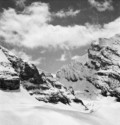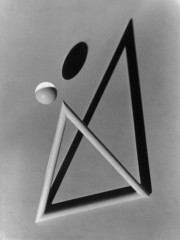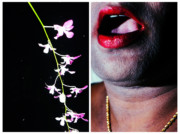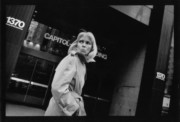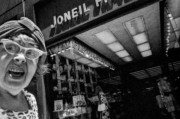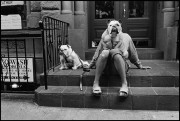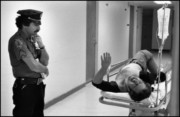Werner Bischof: A Deceptive Simplicity
New Blood Magnum photographer Sohrab Hura writes about how Werner Bischof’s quiet style inspired him
My first encounter with Werner Bischof was when I saw a beautiful photograph of people walking in snowfall in the courtyard of the Meiji shrine: two pairs of overlapping figures walking at the shrine on a day when snow had powdered everything within the photograph and the photograph itself. The snowed-out ground, the shrine wall and the tree line cut into the photograph layers in the most symmetrical manner, so much so that even the trees on either side that were awkwardly left out or brought into the photograph seemed perfect. All these pieces had come together to carry the silence of that snowfall to me. That was many years ago when I had just started to teach myself photography.
The photography that I had been exposed to until then had been predominantly a local one. The kind of photography that had taken me by my hand in my journey up to that point, like the works by Raghubir Singh and Raghu Rai, had been quite loud, much like life around me here in India, and with its chaotic and layered imagery, it had set in me an initial idea of what constructed a good photograph, at least compositionally. When I saw Werner Bischof’s work (and later of photographers like William Gedney and Dayanita Singh) I was initially extremely confused by the way I was attracted to them.
Photographs like the one in Kyoto and those of the silhouettes of the boats with large sails in the bay in Hong Kong were quiet and gentle and had a veneer that was deceptively simple. Even in his photographs from India that I found only later, within the clutter that manages to find its way in most photographs made in this country, there was a similar sensibility running through that always set Bischof’s work aside from everything else from India that I had seen coming from a similar time period by other foreign photographers. Maybe it had something to do with the distance that existed in his work; not necessarily a physical distance but something closer to his state of mind and being. It was something I could never really put my finger on, but it was something that has always stayed. In my early years as a photographer these photographs opened up a window of new explorations and showed me that photography need not conform to the idea of a ‘decisive moment’.
Maybe about four or five years ago, I found myself battling a sort of an existential crisis. From the time I started to learn photography I have been constantly told that one must pick a single line, be it a single line of subject, language, idea or whatever it was that one thought one defined oneself with, and then one had to follow it through. Apparently that was how one went about finding authorship, which, for me, at that time, was the most important achievement for an artist. I have never been able to come to terms with the idea of doing the same thing repeatedly, or at least to not hold myself within too narrow a set of parameters within which to work. More importantly, I could never hold photography to a single purpose because I had always felt that I had responded differently to different things in the world and photography to me was essentially just a tool and no more. Because of this conflict between what I felt and what I had always been told by others in my early and more porous year, I had started to doubt my own ideas and process and for a long phase of time I stopped making any work altogether.
One day as I was idling away time looking at work, by chance I found Werner Bischof again. Going beyond the familiarity of the same beautiful photographs that I had seen so many years ago, I opened up a larger part of his archive. Figures, forms, colors… all reached out to me. His photographs in America did not just lend themselves to the documentation of his time there but he had instead used the medium of color to open up new ways in which to see the world – a new world, fresh after the war, seeming to hold out the promise of an optimistic future, and Bischof seemed to revel in the architecture of this new industrialized space. Cars, Bridges, Buildings and even oil became patterns in the larger picture that he was seeing. Just like his experiments with still life that he had initiated in his teenage years, his photos in America also explored form but with an added element of color. He had now shifted into a dynamic urban space and with it he had let go of a certain romantic look at still life in favor of the banal everydayness of life.
It is not uncommon now to see photographers and estates of photographers of a much older generation who have started to lay out works that they too had made in color long ago, but many of those works are simply an extension of what they were already doing, only that they did it in color. Bischof’s work in color, on the other hand, had a purpose that was entirely different from his other bodies of work. From his early experiments in still life to the more humanistic approach that became a part of the early foundations of documentary photography and his later forays into color, the shift was in formats as well as in distance. Across all of these, one can also see a shift in his approach and reason – in fact, his repeated return to the pure element of form at different intervals made me even wonder if it had actually been a resort to escape the more humanistic side of photography from time to time, which I believe can sometimes take a toll on one’s senses and sensibilities. The familiar quiet sensibility was always there to tie together whatever he did and I found a photographer who seemed to find equal solace exploring the vast breadths of the medium itself as he did in photographing his subjects. That he did all of it by the time he died at 38 years of age made it even more remarkable.
In a general manner of speaking, over the course of most of my photographic life, as short as it is as of now, I’ve very often seen a divide exist between the idea of using photography to document something and the endeavor to push the boundaries of the medium of photography itself. But here I found someone who seemed to have transgressed these artificial boundaries quite easily and at a time when I’m sure that divide must have been even sharper, with fewer spaces for any reconciliation. I’m not sure to what extent this rediscovery of Bischof’s vision and work affected relief from my own struggles with photography but what I do know is that the freedom with which he explored the different corners of the medium was far ahead of its time and that in times of doubt, the legacy of Werner Bischof will always shine through as a beacon.





